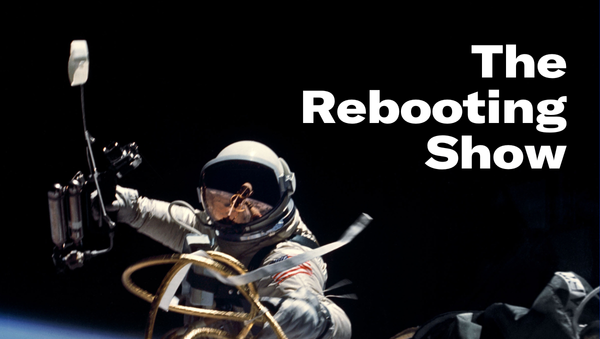AI is coming for media
Better to do things robots can't
No new episode of The Rebooting Show this week. I got waylaid by my European travels last week. In the meantime, subscribe to People vs Algorithms on Apple Podcasts and Spotify. This week:
- How an AI era could impact the nature of creative work, and why it would argue for more human approaches in an environment where much of, if not most of, digital content is largely made by bots.
- Following my discussion with Semafor CEO Justin Smith, some excerpts of feedback from readers/listeners. (I’m refuse to coin some idiotic term for people who get this newsletter.)
- In Recommendations: a reminder that nothing is as permanent as it seems at the time of its peak strength, the mostly pointless peak newsletter debate, the question of hiking subscription rates in uncertain economic times, the ongoing challenge of restoring trust in news, and the dangers of workplaces becoming adversarial.


Keystone by Outbrain™ is the user journey and experience platform from Outbrain. It offers a revolutionary technology that empowers digital publishers to better manage site real estate, prioritize the business needs across the organization and optimize conversion and revenue across diversified KPIs. With Keystone, publishers can:
- Have one holistic view of performance, across all departments, all goals.
- Engage users and earn their loyalty with personalized content and offers
- Optimize for desired business outcomes with AI-powered tools
- Optimize user journeys in alignment with multiple business goals.
- Provide a better experience for audiences.

Is AI coming for my job?
We’re all hypocrites in our own ways. Very few of the laptop class batted an eye when automation and outsourcing came for factory workers. Now, the same forces are coming for professionals in the digital economy, as advances in artificial intelligence point to a future where a lot of media creation will be synthetic.
On the People vs Algorithms podcast, Troy Young, Alex Schleifer and I discuss the future of work in an AI era that Troy describes as in its “Cambrian era.” Technology. It feels like each week a new door opens with AI. I used Lex, a new AI writing assistant, to construct some of the opening to the show, and I have to say Lex got the job done, although I’d argue I’m still needed, not that I’m feeling nervous. Yet it’s natural for humans to feel nervous that the machines are coming to replace us.
In the end, this usually does not happen. Jobs displaced by technology are often replaced by other jobs, many of which are higher level (and better paid). I got programmatic advertising wrong on this front. I thought it was inevitable that automating the backwards ad sales process – I can remember not that long ago how much of the business was still done through faxed insertion orders – would decimate ad buyers and ad sellers. Didn’t happen. Programmatic has not required fewer people, only the skills needed have shifted. As for sales, there is always a need for good sales people – and you can make a lot of money still doing it.
My assumption is the same will occur with AI technologies leading to an avalanche of synthetic media. Assuming this development is a real boom, the nature of many types of creative and production work will change. In the best scenario, we will become super-empowered and even more barriers to media creation will be eliminated. In the worst case, we’ll have bots writing for bots, monetized by bots.
Ben Thompson notes that Snap is leaning more toward direct sales efforts as it looks to dig out of a hole caused, in large part, by Apple’s new data restrictions. (Time to stop calling these “privacy measures.”) Snap has corny-named “SWAT teams” (all military lingo should be banned from anything to do with ad sales) that do hand-holding with clients. This is antithetical, as Ben notes, to the scalable self-service approaches favored by platforms – but it’s also how advertising has always been sold.
People inherently trust other people more often than they do faceless institutions. I assume that’s why so many people infer sinister motives of bureaucracies. It’s easier to hate the “deep state” than your neighbor who works for a FEMA. Rishad Tobaccowala has a good reminder of an important truism: “While we are surrounded by algorithms that are data driven, digital and operated on silicon chips, we should never forget that people are analog, carbon based and feeling driven.”

One of the interesting trends I’m seeing now is new publications arising that are taking a lean media approach to their tech stack. There’s always a tremendous advantage in cutting down on complexity. Ben May of development specialists The Code Company shared how they approach building a modern tech stack for publishers:
“We’ve had a lot of success with what we call our “anti-complexity” approach to tech stacks. Publishers often come to us after heavily investing time and money on a custom CMS, or a needlessly complex solution. It’s essentially been overkill for their needs, and they’re finding it not only costly to maintain, but a lot of time and work to add basic functionality. We’ve yet to come across a need when publishing at scale, that can’t be solved using open source tools such as WordPress. When so much comes out of the box, you can invest strategically on features that generate revenue and use your budget on the bells and whistles that will truly set your business apart.”

First Impressions: Semafor
One of the things I like best about newsletters is the interaction they lead to with readers. I want to feed some of the insights I get from these interactions back into The Rebooting. Please send me a note anytime you have feedback on a topic covered: bmorrissey@gmail.com.
Last week, I spoke to Semafor CEO Justin Smith and wrote initial impressions of Semfor’s launch. Some notable pieces of feedback:
- What’s the need again?: “It really looks like a solution in search of a problem. It seems to me like a generic news outlet done by and targeting old schoolers. This can be a positioning in itself, sure, but rather a niched, contrarian one looking at the whole media ecosystem evolution.”
- The personalities: “At the end of the day I think it's all about the reporters and personalities at this point. For example, I followed you here because of your sensibilities and the way you deliver information. Previously you did that at Digiday, which even though it was through the lens of Digiday, it was easy to see your own personal take. People will go to Semafor for the Smiths. Then will it be good? Who knows.”
- Forget “unbiased” as a selling point: “The quality of any news product that responds to users who say they are "tired of bias" will depend entirely on the interpretation given to those words. And there is no unbiased way to interpret them. If such a product succeeds it will not by removing bias from the product, but by introducing a sensitive and novel POV that somehow reads as fair and factual to a substantial crowd of people.”
- It’s the email, stupid: “ I’m bullish on the newsletter model. I think it works as a distribution vehicle. I don’t know how much the consumer can handle in terms of subscription cost, but I think aggregator models and sponsorship will work in this area. Sounds like this is what Semafor is doing.”
- Semafor yellow: “Can’t get over the fact that the website looks like the menu from a private-equity owned brasserie.”

Recommendations
Nothing is permanent. A human tendency is to see the most powerful entities of today as infallible and likely the titans of tomorrow. We assume growth to be linear, when it’s a total mess in reality. Facebook, which 18 months ago was nearing the milestone of a $1 trillion market cap, is now facing activist shareholder pressure to cut back spending and staff after an era of “too many people, too many ideas, too little urgency.”
We have moved from “peak newsletter” to “post-peak newsletter,” apparently. The New York Times takes a temperature check on newsletter mania and unsurprisingly, like all manias, finds that the typical internet power law in effect. I agree with Axios CEO Jim VandeHei’s simple assessment: “Great video = Great biz; Great podcast=great biz; great newsletter=great biz; great content = great biz. Crap video, crap pods, crap content = crap biz.”
Subscriptions are a nice model when facing a recession since you typically get paid upfront for a year’s worth of delivery. People can cancel, but you’re not giving pro-rated refunds. Where it does particularly pinch is in attracting new customers. My former colleague Jack Marshall at Toolkits did research that found few publishers are following the lead of many streaming services in hiking prices.
The Financial Times pulled off a massive consumer survey of its email newsletter subscribers, gathering nearly 80,000 responses since March. One key finding: “The newsletters that have scored the best are the ones with huge personality and expertise.”
The biggest challenge for the news industry is restoring trust. Operating any business or just as an individual in very polarized times is challenging to avoid getting sucked into various culture wars. One place to start is examining the typical if-it-bleeds-it-leads approach to news coverage. Overall, many forms of media have grown gloomier and more catastrophic. News is no different. This is not just a function of the times we live in, but I also don’t see it as some kind of grand conspiracy you hear peddled by people who use terms like “woke capitalism.” It’s a nuanced issue we’re going to discuss in the next episode of People vs Algorithms.
One sign of overall media pessimism is the growth of unions. Hearst is onto year 3 of its battle with unions. Insider continues to be roiled by staff complaints. I would not have thought when entering this profession 20-plus years ago to find so many media organizations organized. Some of this is a reap-what-you-sow situation, while I believe it is a piece of an overall trend toward fixed mindsets in mature economies where labor precarity has never been higher.
But employers do themselves no favors. The war on flexible work waged by the Boss Class and attempts to quantify everything have sown distrust. “Productivity paranoia” – vying to be the Boss Class version of the “quiet quitting” fake trend – is part of a lack of trust that exists within companies. The adversarial company, where unionized workers are pitted against spying bosses, is not set up for the future.
We could all do well to follow the lead of Sonia Sotomayor in making the effort to see the good in people who we disagree with on political issues.

Thanks to Outbrain and The Code Company for sponsoring. If you’re interested in sponsoring The Rebooting, please check out the sales kit and get in touch.
Reminder: Please let me know if you’re interested in receiving invites to upcoming events from The Rebooting.
If you’re enjoying The Rebooting, please share it with others you think would also find it valuable.





